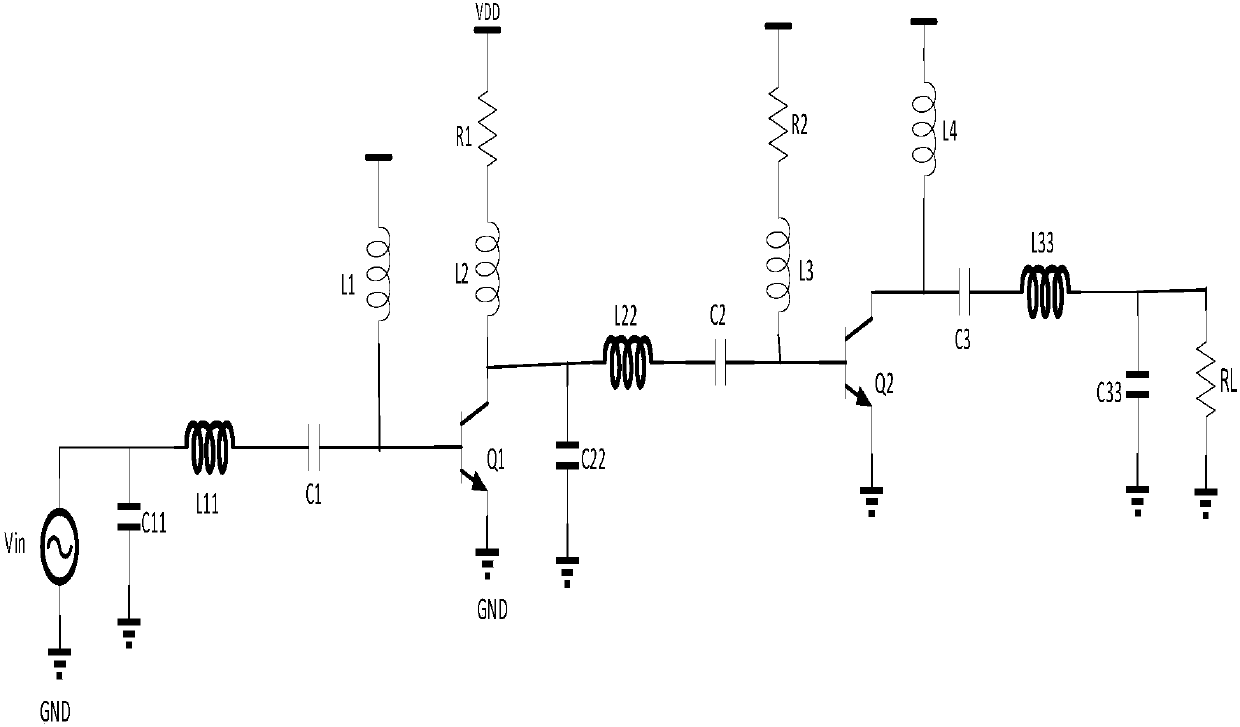Ka-band SiGe BiCMOS radio frequency power amplifier
A radio frequency power and power amplifier circuit technology, applied in power amplifiers, radio frequency amplifiers, amplifiers, etc., can solve the problems of poor current driving ability, difficult integration, poor performance of on-chip passive devices, etc. Effects of integration, high eigenfrequency and noise characteristics
- Summary
- Abstract
- Description
- Claims
- Application Information
AI Technical Summary
Problems solved by technology
Method used
Image
Examples
Embodiment 1
[0028] Such as figure 2 A Ka-band SiGe BiCMOS RF power amplifier is shown, which is used in fully integrated RF circuits, communication SOC and other fields, including input matching network, pre-stage gain amplifier circuit, inter-stage matching network, post-stage power amplifier circuit and impedance transformation network, which in turn are connected;
[0029] Both the pre-stage gain amplifier circuit and the rear-stage power amplifier circuit include SiGe BiCMOS;
[0030] The input terminals of the front-stage gain amplifier circuit and the rear-stage power amplifier circuit are respectively connected with a first bias circuit and a second bias circuit.
[0031] The above-mentioned circuit can have good power output and gain by means of two stages with different emphases. And because the SiGe transistor has a heterojunction structure with a wide-bandgap emitter region, the carrier injection efficiency of the emitter junction is greatly improved, the carrier drift movem...
Embodiment 2
[0033] This embodiment is optimized on the basis of the above embodiments, that is, the circuit structures of the input matching network, the interstage matching network and the impedance transformation network are the same. The three circuits adopt the same circuit structure, which can not only improve the consistency, but also ensure the stability of the circuit. Specifically, such as image 3 As shown, it can adopt the following structure, that is, it includes a first inductor and a first capacitor connected in series at the input end, and a second capacitor connected at the input end and the other end is grounded.
[0034] Such as figure 1 As shown, the input matching network includes inductor L11, capacitor C1, and capacitor C11, the interstage matching network includes inductor L22, capacitor C2, and capacitor C22, and the impedance transformation network includes inductor L33, capacitor C3, and capacitor 33. The impedance transformation network includes an inductor L3...
Embodiment 3
[0037] On the basis of the above examples, if image 3 As shown, the front-stage gain amplifying circuit, the post-stage power amplifying circuit, the first bias circuit, and the second bias circuit can adopt the following structures.
[0038]The first bias circuit includes a second inductance L1, and the two ends of the second inductance are respectively connected to the input terminal of the pre-stage gain amplifier circuit and the power supply.
[0039] The second bias circuit includes a second resistor R2 and a fifth inductor L3 connected in series with one end connected to the power supply and the other end connected to the input end of the subsequent power amplifier circuit. With the bias circuit of this structure, the inductance in the bias circuit participates in matching and impedance transformation, which can effectively reduce the use of original components, reduce the cost, reduce the area, and have reliable performance.
[0040] The pre-stage gain amplifier circu...
PUM
 Login to View More
Login to View More Abstract
Description
Claims
Application Information
 Login to View More
Login to View More - R&D
- Intellectual Property
- Life Sciences
- Materials
- Tech Scout
- Unparalleled Data Quality
- Higher Quality Content
- 60% Fewer Hallucinations
Browse by: Latest US Patents, China's latest patents, Technical Efficacy Thesaurus, Application Domain, Technology Topic, Popular Technical Reports.
© 2025 PatSnap. All rights reserved.Legal|Privacy policy|Modern Slavery Act Transparency Statement|Sitemap|About US| Contact US: help@patsnap.com



